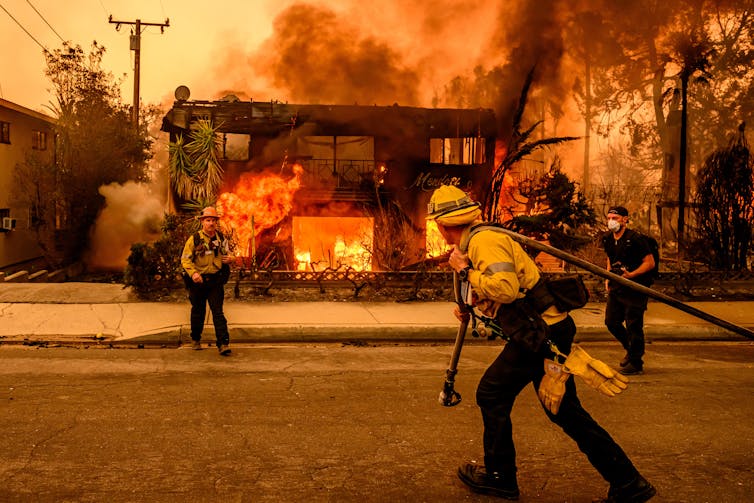Thousands of firefighters and other first responders on the front lines of wildfires raging across the Los Angeles area are at increased risk for anxiety, depression, acute stress and post-traumatic stress disorder.
Amanda Mascarelli, senior editor for U.S. health and medicine at The Conversation, spoke with clinical psychologist and emergency medicine researcher Ian H. Stanley to discuss acute Early signs of stress or post-traumatic stress disorder (PTSD) and how you can help if a loved one is experiencing these symptoms.
What is the difference between short-term and long-term PTSD?
Post-traumatic stress disorder (PTSD) is a mental health condition that develops after a life-threatening event such as a wildfire, car accident, physical assault or combat. It involves the development of characteristic symptoms that appear or worsen after trauma and last for at least a month.
Symptoms include nightmares, reliving events, feelings of guilt, hopelessness, or hypervigilance, which means being constantly alert to future threats. Symptoms may also involve sleep disturbances and avoidance of triggers or reminders of certain events. Another important point is that the symptoms must also involve considerable distress or some degree of impairment in someone's life, such as disruption to relationships, work, school, or self-care.
What are the potential early signs of acute stress or post-traumatic stress disorder (PTSD)?
During this emergency phase, when first responders are extinguishing fires, they are trained to keep their heads down and overcome truly difficult events, although they are extremely stressful. That doesn't mean they won't be affected, but at this stage, you probably won't see many symptoms.
But that doesn't mean they may not continue to experience symptoms, such as sadness, irritability, or ongoing sleep disturbances. In the long term, some people may develop post-traumatic stress disorder. Therefore, it is important for people to be vigilant about their own mental health and that of others around them.
The most important thing to look out for are any significant changes. People experience and react to trauma in many different ways, so there is no specific formula. It is crucial to remain alert to noticeable changes in others. For example, does someone eat more or less? Do they sleep more or less? Are they more grumpy than before? Do they drink more alcohol? Are they hanging out with friends less? Have activities they previously enjoyed declined? If you see someone going through these types of changes, reach out to them and offer support.
One of the reasons PTSD symptoms are so concerning is that it is one of the few mental health conditions that can predict suicidal thoughts and behaviors very reliably. Therefore, it is important to detect the signs early to prevent the progression of the disease.

What about other signs of stress that are different from post-traumatic stress disorder (PTSD)?
It’s important to stress that it’s normal for people to feel sad, angry and anxious after a disaster or other traumatic event.
That said, there is a mental health condition called acute stress disorder, much like PTSD. While PTSD symptoms need to be present for at least a month, acute stress disorder is diagnosed when symptoms persist for at least three days and up to a month after trauma exposure. In these cases, a person may experience symptoms such as nightmares, persistent negative moods, irritability, sleep disturbances, or related conditions.
This diagnosis opens up the opportunity for certain treatments that may be reimbursed through insurance and certain service pathways. Many people with acute stress disorder experience temporary stress reactions but do not develop post-traumatic stress disorder (PTSD); however, about half of people with PTSD initially experience acute stress obstacle.
Do early symptoms of post-traumatic stress disorder (PTSD) always translate into long-term symptoms?
This is a very important question. When the world someone's known is torn apart and turned upside down (like the fires in Southern California), it's normal for people to think, feel, or behave differently. Sadness is normal. Anxiety is normal. Most people who experience these changes get better within a few weeks, and most do not develop mental health problems such as post-traumatic stress disorder (PTSD).
People take many different treatments based on their symptoms. Many people get better over time. Time is a great healer—and so is social support.
But if symptoms persist, it's crucial to seek help from a mental health professional.
The prevalence of PTSD among first responders is higher than in the general population. As many as 20% of first responders to natural disasters such as wildfires may go on to develop post-traumatic stress disorder (PTSD).
Importantly, firefighters are at increased risk if they work in the communities where they live and their personal lives are affected.
What treatment options are available for post-traumatic stress disorder (PTSD)?
There are very effective treatments, and PTSD doesn't have to be a life sentence. Treatment options include medication and psychotherapy. Some people may benefit from a mobile wellness app, such as the free-to-access “PTSD Coach.”
The National Center for Post-Traumatic Stress Disorder, part of the Department of Veterans Affairs, also provides helpful resources for family members and loved ones of those who may be suffering from PTSD.